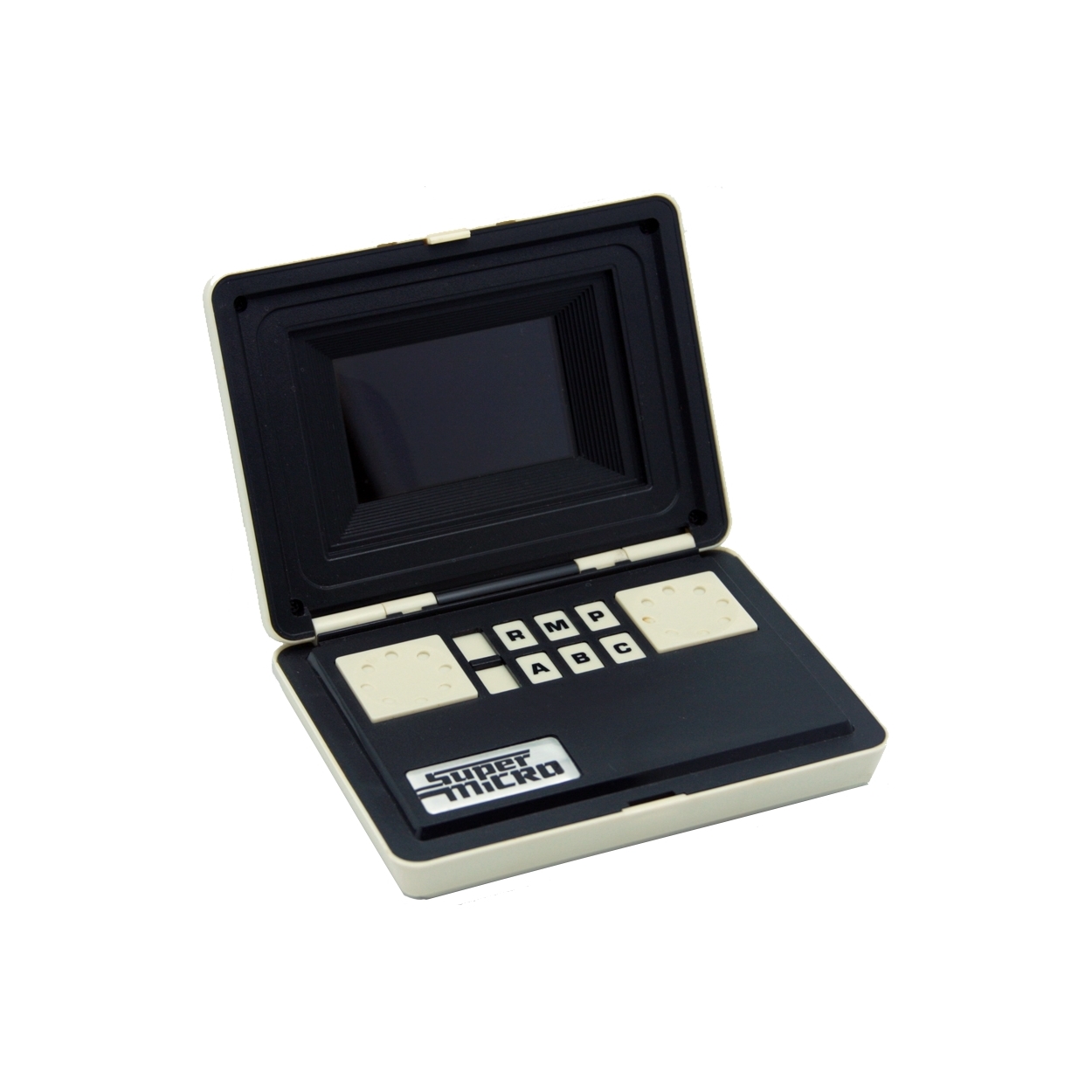|
|
|
History
The story of the Super Micro start in the early ’80s, when Esmail Amid-Hosur arrived in the United States. With his strong business acumen, Esmail quickly made a few connections in the import/export business and soon find itself in Japan looking for the next big thing. It wasn’t long before Esmail stumbled on the new craze of the moment in Japan, the Nintendo Game & Watch. Esmail managed to convince Nintendo to let him import the Game & Watch in North America. Esmail started by import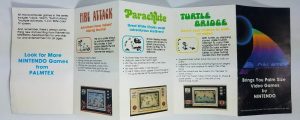 ing a small lot of 300 devices to test the market. The response was amazing and he sold all of them without any effort. Seeing the potential of the Game & Watch, Esmail founded Palmtex on March 22, 1982, and like this, Palmtex became the first company to import Nintendo video game console in North America.
ing a small lot of 300 devices to test the market. The response was amazing and he sold all of them without any effort. Seeing the potential of the Game & Watch, Esmail founded Palmtex on March 22, 1982, and like this, Palmtex became the first company to import Nintendo video game console in North America.
Esmail decided to open his offices at 1167 Chess Drive, in the heart of Silicon Valley with the other big players of the time in video games and microcomputer like Apple, Atari, IBM and Intel.
The Game & Watch were very popular and Palmtex decided to import other portable consoles such as the ones from V-Tech. By the end of 1982, the demand for handheld video game systems was at its peak and Palmtex decided to create its own portable video game system called the PVS.
The Palmtex Video System (PVS) was officially registered on January 19, 1983, along with the title of 5 games: Spellbound, Star Trooper, Mayday, Minefield and Crystals of Morga. The design of the PVS was first given externally to a Californian firm for the sum of $400,000. Esmail managed to create a very solid team with Glenn Helton in charge of the marketing and Barry Becker in charge of the sale, but the team was missing a key player to manage the subcontractor design of the console. With that in mind, Esmail managed to find his Chief Engineer in Robert F. Sagarino.
Born in Long Island Bob was an extremely inventive person. Although he did not have a degree in Engineering, Bob had an extremely impressive career. He had worked, among other places, has head of research and development for Bulova and head of engineering at Timex
After joining the team, Bob started by reviewing the deliverable of the subcontractor. He rapidly understood that the subcontractor was going nowhere and decided to terminate the contract and to repatriate the design and the engineering in-house. He hired three engineers to do the industrial design and the electronic of the PVS. He also signed a contract with Home Computer Software (HCS), a company founded by Jon Tedesco to create the games. HCS who had already created games for the Atari and the Commodore 64 quickly demonstrated that they were a very competent group and were giving some latitude in the choice of games to be developed. Dan Schaefer, the lead designer for HSC hired Chuck Blanchard specifically to work on the PVS game. While Dan did the design, Chuck wrote both React-Attack and Aladdin’s Adventures and an outside consultant was brought in to work on Outflank. With this new partnership, the development of the console and games progressed smoothly.
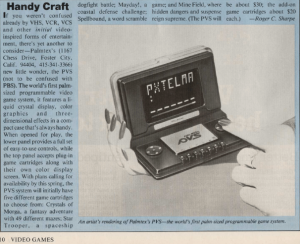 At the time, the PVS had almost no marketing done for it. A few articles here and there were promoting the upcoming console. One of them in the magazine Video Games of May 1983 gave a sketch of what the console should look like, but it was not before September of 1983 at the Internationale Funkausstellung that the consumer had a chance to see the first glance of the PVS.
At the time, the PVS had almost no marketing done for it. A few articles here and there were promoting the upcoming console. One of them in the magazine Video Games of May 1983 gave a sketch of what the console should look like, but it was not before September of 1983 at the Internationale Funkausstellung that the consumer had a chance to see the first glance of the PVS.
The Internationale Funkausstellung (IFA) was the world’s largest trade fair for consumer electronics and Palmtex wanted to showcase their product. The console itself was not ready, and to be able to show a functional prototype, the breadboard was hidden under the counter and was connected to the PVS through an external connector. At the time the console was made of a transparent plastic to put the 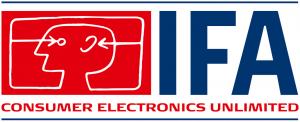 focus of the inside of the machine. The PVS had drawn a lot of attention during the IFA and Palmtex was very confident that they had everything they needed to succeed.
focus of the inside of the machine. The PVS had drawn a lot of attention during the IFA and Palmtex was very confident that they had everything they needed to succeed.
Back from the IFA, Palmtex finalized the design and by the end of 1983, Bob used his contact at National Electronics & Watch Co Ltd in Hong Kong to start the production of the first 30,000 PVS units. The first units were delivered just in time to be showcased at the CES of January 1984 in Las Vegas. This iteration of the CES broke the attendance record with more than 100,000 participants. But with the beginning of the crash of the video game industry and the less than appealing line up of games and software at the CES, the time of video games seems to be a thing of the past.
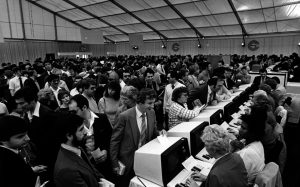
It’s in that context that the PVS was offered to the distributor for the first time. Although the PVS had numerous improvements over the other handheld of the time (smaller, more powerful, etc.) it also had one major flaw. The screen of the PVS is transparent and needed enough natural light coming from the back of the console in order to see anything. This seriously impaired the portability of the console as you always need to be in front of a light to play the game, even during the day. The problem was not without a solution, but in a tumbling market, no distributor wanted to introduce a new device, especially a flawed one.
With no order received at CES, Palmtex turned to a round of Venture Capital to raise the necessary fund to continue to project. With the state of industry at the time, the response was frigid. With this news, it was clear that there would be no money to improve the PVS and the device seems to be officially dead. At this point many employees left the company.
Palmex had invested a lot of money in the PVS and eventually defaulted on a bank loan. The bank seized the PVS stock contacted HCS to see if they could help dispose of the inventory they repossessed.
To achieve this, HCS had to first resolve the issue for the dim screen. A simple workaround was created by Jon Tedesco by simply adding a light box that would attach behind the device to provide additional lighting if required. The second change was the name. HCS decided to dissociate the product as much as possible from Palmtex who just bankrupted and changed the name to Super Micro to appeal to the microcomputer market which was still blooming in 1984. HCS was blooming at the time as a software developer and having his name associated with the Super Micro instead of Palmtex could only increase the chance of the device being successful.
As the bank needed to fund the creation and production of the lightpak, boxes and marketing material, they settled for a control launch in a small test market to see if the product could be successful. 10,000 LightPak and boxes were made as a start. The Super Micro was finally made available via mail order for $39.95 in the bay area. The “LightPak” was 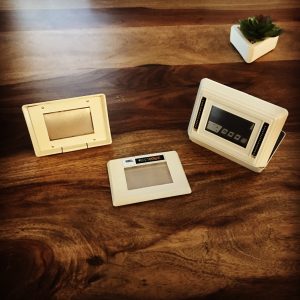 sold for $19.95 while each game was sold for $14.95. A “Deluxe Pack” containing the console, a “LightPak” and a game of your choice was also available for $59.95. Due to this, 3 different packaging exists for the Deluxe Pack, one for each possible game.
sold for $19.95 while each game was sold for $14.95. A “Deluxe Pack” containing the console, a “LightPak” and a game of your choice was also available for $59.95. Due to this, 3 different packaging exists for the Deluxe Pack, one for each possible game.
Sadly, only about 5,000 units were sold, which was insufficient for the bank to pursue this route. The rest of the units are rumored to have been destroyed. Additional games were still in development for the device, but with the bank shutting down the Super Micro, HCS stopped all development. Home Computer Software continued to make games for a while. Bob Sagarino hooked them up with Timex, who was developing a home computer. They eventually contracted with them to develop almost all of their gaming and educational software which they did on a joint venture basis. As such they were not being paid for the development but instead would receive money on the sale. Unfortunately, Timex pulled out of this business shortly after launch and the huge investment HCS made in creating all their software never generated a return. This is forced HCS to close its doors.
Games
Only 3 games were ever released for the console. Each game is available either in stand-alone or as a pack-in with the Deluxe Pack.
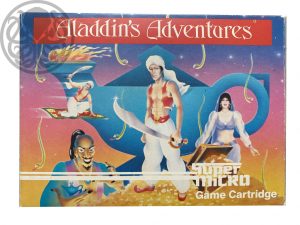 |
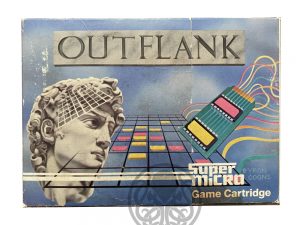 |
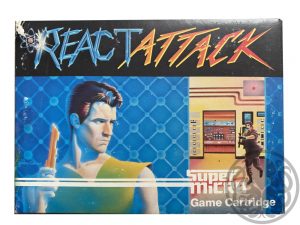 |
|||
| Aladdin’s Adventures [Watch] |
Outflank [Watch] |
React Attack [Watch] |
F.A.Q
- Only 5,000 units have been sold. See this tracking sheet.
- With time, the plastic shell may have shrunk a bit making almost impossible to remove the cover from the batteries compartment when batteries are inside. To avoid this situation, simply avoid to put the cover on the batteries compartment. In case you acquired the console already in this state, you can simply unscrew the bottom part of the console and remove the control panel. You will have a direct access to the batteries this way and will be able to safely remove them without damaging the shell or the batteries cover.
Disclaimer
The information gathered in this article is mainly a summary of discussion I had with various former employees/associates of Palmtex and HomeComputer Software. Although all the information provided though the interviews I conducted with the former employees was to the best of their recollection, at the time of the interviews, more than 35 years had passed since the PVS was first conceived so some detail may not be 100% accurate.

